The Belfast Blitz: Lost Church Memorials
Researched and written by Nigel Henderson
According to official Air Raids Situation Reports (PRONI File MPs1/2/2), 68 places of worship in Belfast were damaged during the German air raids of 1941. Five were in Belfast city centre, three were in the Shankill area, 28 were in East Belfast, and 32 were in North Belfast. Inevitably, many memorials commemorating service and sacrifice in the Great War were also lost due to the bombings.
Rosemary Street Presbyterian Church
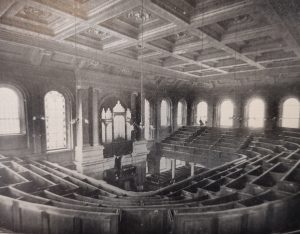 On Sunday 12th October 1919, the new War Memorial Organ in the church was used for the first time in public worship. In his address, Dr Park referred to the 555 men from the congregation and Sabbath School who had served in the Great war, 86 of whom had made the supreme sacrifice. The following Sunday, Mrs John Sinclair unveiled a brass tablet which had been erected by the afternoon Sabbath School in memory of the members of the congregation and school who fell in the Great War. The newspaper article on the unveiling reported that the tablet was attached to the front of the pulpit and recorded the names of the 86 fatalities. The church was not rebuilt and the congregation amalgamated with Ekenhead Memorial Presbyterian Church at its new site on the North Circular Road, adopting the name Rosemary Presbyterian Church. A history of the congregation by J W Kernahan includes a photograph of the War Memorial Organ, and the plaque on the front of the pulpit is visible.
On Sunday 12th October 1919, the new War Memorial Organ in the church was used for the first time in public worship. In his address, Dr Park referred to the 555 men from the congregation and Sabbath School who had served in the Great war, 86 of whom had made the supreme sacrifice. The following Sunday, Mrs John Sinclair unveiled a brass tablet which had been erected by the afternoon Sabbath School in memory of the members of the congregation and school who fell in the Great War. The newspaper article on the unveiling reported that the tablet was attached to the front of the pulpit and recorded the names of the 86 fatalities. The church was not rebuilt and the congregation amalgamated with Ekenhead Memorial Presbyterian Church at its new site on the North Circular Road, adopting the name Rosemary Presbyterian Church. A history of the congregation by J W Kernahan includes a photograph of the War Memorial Organ, and the plaque on the front of the pulpit is visible.
Clifton Street Presbyterian Church
Two white marble tablets were unveiled on Sunday 7th March 1920 – one commemorated the nineteen men of the congregation who died and one recorded the names of those who served and survived. The tablets were unveiled by Mrs Anna Craig Picken of Antrim Road, who had a noble record of work on behalf of soldiers and sailors. The church was not rebuilt, and the congregation merged with the nearby Clifton Street United Free Presbyterian Church. The amalgamated congregation adopting the name Clifton Street United Presbyterian Church.
York Street Presbyterian Church
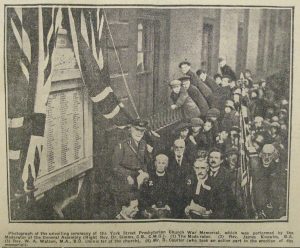 On Sunday 25th April 1920, two memorials were unveiled at the church by the Right Reverend Doctor John Morrow Simms, Moderator of the Presbyterian Church in Ireland, who had served as Senior Chaplain to the Ulster Division during the war. One of the mural tablets was erected inside the church and commemorated fourteen men from the congregation who died during the war. The second mural tablet was erected by 33rd Company Boy Scouts and was placed on external wall of the church at the junction of York Street and Earl Street. This memorial tablet recorded the names of 132 men from Earl Street and District who served in the Great War, 36 of whom paid the ultimate sacrifice. Newspaper articles about the unveilings recorded the names of those commemorated on the two tablets, although none of the fatalities named on the congregational tablet are named on the district tablet. In essence, the external tablet probably represented service and sacrifice by people who lived in the streets between Gallaher’s Tobacco factory and the York Street Flax Spinning mill. To the best of my knowledge, no photographs of either memorial tablet have survived, although there is a newspaper photograph of the unveiling of the district memorial. The church was not rebuilt, and the congregation merged with Castleton Presbyterian Church on York Road, the amalgamated congregation adopting the name of Alexandra Presbyterian Church.
On Sunday 25th April 1920, two memorials were unveiled at the church by the Right Reverend Doctor John Morrow Simms, Moderator of the Presbyterian Church in Ireland, who had served as Senior Chaplain to the Ulster Division during the war. One of the mural tablets was erected inside the church and commemorated fourteen men from the congregation who died during the war. The second mural tablet was erected by 33rd Company Boy Scouts and was placed on external wall of the church at the junction of York Street and Earl Street. This memorial tablet recorded the names of 132 men from Earl Street and District who served in the Great War, 36 of whom paid the ultimate sacrifice. Newspaper articles about the unveilings recorded the names of those commemorated on the two tablets, although none of the fatalities named on the congregational tablet are named on the district tablet. In essence, the external tablet probably represented service and sacrifice by people who lived in the streets between Gallaher’s Tobacco factory and the York Street Flax Spinning mill. To the best of my knowledge, no photographs of either memorial tablet have survived, although there is a newspaper photograph of the unveiling of the district memorial. The church was not rebuilt, and the congregation merged with Castleton Presbyterian Church on York Road, the amalgamated congregation adopting the name of Alexandra Presbyterian Church.
St James’ Church of Ireland, Antrim Road
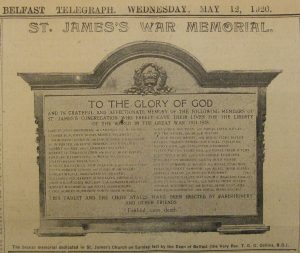 On 9th May 1920, the Very Reverend Thomas Gibson George Collins, Dean of Belfast dedicated memorials commemorating the service and sacrifice by men from the parish. Choir stalls and a bronze mural tablet, on which the names of thirty fatalities were recorded, was erected by congregational subscription. Mr Andrew Alexander Clendinning, a linen merchant, gifted the Roll of Honour tablet which recorded the names of 156 men who served and survived. Mrs Mary Kathleen Watson gifted a prayer desk in memory of her husband, the Reverend John Edmund Malone Watson MC, who was a chaplain to the forces and died of wounds on 10th April 1918, aged 31. In the 1943 Belfast Street Directory, the site was recorded as “Vacant” and the church was restored by 1947.
On 9th May 1920, the Very Reverend Thomas Gibson George Collins, Dean of Belfast dedicated memorials commemorating the service and sacrifice by men from the parish. Choir stalls and a bronze mural tablet, on which the names of thirty fatalities were recorded, was erected by congregational subscription. Mr Andrew Alexander Clendinning, a linen merchant, gifted the Roll of Honour tablet which recorded the names of 156 men who served and survived. Mrs Mary Kathleen Watson gifted a prayer desk in memory of her husband, the Reverend John Edmund Malone Watson MC, who was a chaplain to the forces and died of wounds on 10th April 1918, aged 31. In the 1943 Belfast Street Directory, the site was recorded as “Vacant” and the church was restored by 1947.
St Silas’ Church of Ireland, Oldpark Road
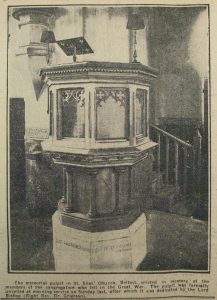 This church was located on the corner of Oldpark Road and Ardoyne Avenue and was built in 1901. On Sunday 30th May 1920, the Right Reverend Doctor Charles Thornton Primrose Grierson (Bishop of Down, Connor and Dromore) dedicated a new pulpit in the church as a memorial to those from the parish who had died in the Great War. The pulpit of white oak was manufactured by Purdy and Millard of Howard Street and a brass plate on the front panel named thirty fatalities, under the headings Navy and Army. On the base of the pulpit were carved the words of His Majesty King George V, “The men of Ulster have proved how nobly they fight and die.” The memorial was unveiled by Mr James Barlowe and Mr James Bustard, two former churchwardens who had both lost their only sons in the war. In his address, the Lord Bishop stated that 160 men from the church had volunteered for service in the Great War. The memorial cost £150, which equates to approximately £5,500 in current terms. Newspaper reports on the unveiling ceremony recorded the names of the fatalities and a photograph of the memorial pulpit was published in the Belfast Telegraph. The 1951 and 1955 street directories record that the site for the replacement church was located at the junction of Cliftonville Road and Cardigan Drive, and the new church was completed in 1958.
This church was located on the corner of Oldpark Road and Ardoyne Avenue and was built in 1901. On Sunday 30th May 1920, the Right Reverend Doctor Charles Thornton Primrose Grierson (Bishop of Down, Connor and Dromore) dedicated a new pulpit in the church as a memorial to those from the parish who had died in the Great War. The pulpit of white oak was manufactured by Purdy and Millard of Howard Street and a brass plate on the front panel named thirty fatalities, under the headings Navy and Army. On the base of the pulpit were carved the words of His Majesty King George V, “The men of Ulster have proved how nobly they fight and die.” The memorial was unveiled by Mr James Barlowe and Mr James Bustard, two former churchwardens who had both lost their only sons in the war. In his address, the Lord Bishop stated that 160 men from the church had volunteered for service in the Great War. The memorial cost £150, which equates to approximately £5,500 in current terms. Newspaper reports on the unveiling ceremony recorded the names of the fatalities and a photograph of the memorial pulpit was published in the Belfast Telegraph. The 1951 and 1955 street directories record that the site for the replacement church was located at the junction of Cliftonville Road and Cardigan Drive, and the new church was completed in 1958.
Newington Presbyterian Church, Limestone Road

On Sunday 5th September 1920, the memorial was unveiled by Mrs Samuel Jordan of Lisnagarvey and dedicated by the Reverend Thomas McGimpsey Johnstone, Minister of the congregation. In reporting the Reverend Johnstone’s address, The Witness recorded that, “He could not help feeling that the names on the brass tablet did not represent all in that congregation who had died for their country. Scarcely a month went past without the death occurring of someone whose name ought to be transferred from the ordinary Roll of Honour to the tablet of the glorious dead.“ Reverend Johnstone went on to refer to one of the members of the Sabbath School who had gone away before he was 17 years of age, had been awarded the Military Medal, and had died just days before the memorial was unveiled. The memorial took the form of a cabinet, similar to the memorial in Shankill Parish Church in Lurgan. When opened, a brass plaque naming 66 fatalities was revealed in the body of the cabinet, whilst the names of 340 members of the congregation who served and survived were inscribed on brass plaques on the insides of the doors. The first person named on the fatalities’ plaque was VAD Nurse Margaret Cameron Young who was serving at No 2 General Hospital when she died of illness, probably influenza, on 30th July 1918, aged 25. She is buried in Terlincthun British Cemetery at Wimille in France and is commemorated on a family memorial in Shankill Graveyard. A memorial tablet was erected in the Minister’s Room in her memory in 1920. The church was rebuilt in 1951/1952 and a plaque in the foyer records that the current building replaced the 1875 building that was destroyed in 1941. A generic bronze plaque and an illuminated Book of Remembrance in an oak cabinet were dedicated as a war memorial on Remembrance Day in 1957. The memorial was unveiled by Miss Helen Cameron Young, whose sister was the only female commemorated on the original memorial.
Mervue Mission Hall
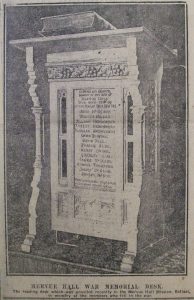 On Sunday 19th September 1920 a reading desk was dedicated as a memorial in this mission hall, which was associated with Donegall Street Congregational Church. The desk was unveiled by Captain William Reid and the names of fourteen fatalities from the congregation are recorded on the front of the desk. The newspaper coverage of the unveiling service included a photograph of the memorial and the hall had been re-opened by 1945.
On Sunday 19th September 1920 a reading desk was dedicated as a memorial in this mission hall, which was associated with Donegall Street Congregational Church. The desk was unveiled by Captain William Reid and the names of fourteen fatalities from the congregation are recorded on the front of the desk. The newspaper coverage of the unveiling service included a photograph of the memorial and the hall had been re-opened by 1945.
St Barnabas’ Church of Ireland, Duncairn Gardens
On 13th March 1921, the Reverend Dixon Patterson, Rector of the church, unveiled and dedicated a memorial tablet and Roll of Honour to commemorate the sacrifices and services of members of the congregation in the Great War. A large chandelier with electric lights (or electrolier) for the chancel formed part of the war memorial. The memorial tablet recorded the names of 31 men who had died in the war, and the Roll of Honour recorded the names of 168 men from the congregation who had returned home. The latter, the work of William Rodman & Company of Donegall Place and Fountain Street, was seven feet long and five feet high, and featured Celtic ornamentation. Although the names of the fallen were recorded in newspaper coverage of the unveiling, no photographs appeared in the local press. It is not known whether there are any photographs of the memorial tablet or the Roll of Honour tablet. The church and the adjacent St Barnabas’ Public Elementary School were destroyed or demolished and St Barnabas’ Church Hall is recorded at the site of the church in the 1951 Belfast Street Directory. A new church was built on the site by 1960 and the congregation later merged with St Paul’s Church of Ireland on York Street.
Duncairn Gardens Methodist Church
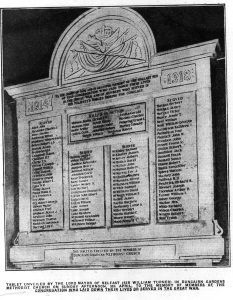 On 7th April 1925, Sir William Turner JP, Lord Mayor of Belfast, unveiled a polished marble tablet which recorded and the names of the fourteen members of the congregation who died and the names of a further 100 people who served in the Great War. The memorial was the work of Thompson & Sons of Limestone Road and the embellishment at the top of the tablet features crossed flag and the Dove of Peace under a Crown. A photograph of the memorial was published in the Belfast Telegraph in April 1925 and a fine photograph of the memorial can be found online. The church was never rebuilt, and the congregation merged with Carlisle Memorial Methodist Church.
On 7th April 1925, Sir William Turner JP, Lord Mayor of Belfast, unveiled a polished marble tablet which recorded and the names of the fourteen members of the congregation who died and the names of a further 100 people who served in the Great War. The memorial was the work of Thompson & Sons of Limestone Road and the embellishment at the top of the tablet features crossed flag and the Dove of Peace under a Crown. A photograph of the memorial was published in the Belfast Telegraph in April 1925 and a fine photograph of the memorial can be found online. The church was never rebuilt, and the congregation merged with Carlisle Memorial Methodist Church.
Other destroyed or demolished churches where war memorials were probably lost include:
Holy Trinity Church of Ireland on Unity Street, which was not rebuilt,
York Street (Non-Subscribing) Presbyterian Church, which was not rebuilt,
Crumlin Road Presbyterian Church, which was rebuilt by 1955,
Macrory Memorial Presbyterian Church, which was rebuilt by 1955.
Sources of images:
Newspaper images are from the Great War Ulster Newspaper Archive.
Newington Presbyterian Church memorial courtesy of Ricky Cole
Photograph of the War Memorial Organ in Rosemary Street Presbyterian Church is from “Rosemary Street Presbyterian Church: a record of the past 200 years” by J. W. Kernohan (1923)


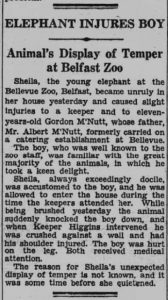 After the German air raid on the night of 15th/16th April 1941, Antrim Road residents raised concerns that dangerous animals might escape during air raids. The account in Scott Edgar’s
After the German air raid on the night of 15th/16th April 1941, Antrim Road residents raised concerns that dangerous animals might escape during air raids. The account in Scott Edgar’s 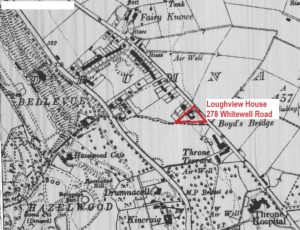
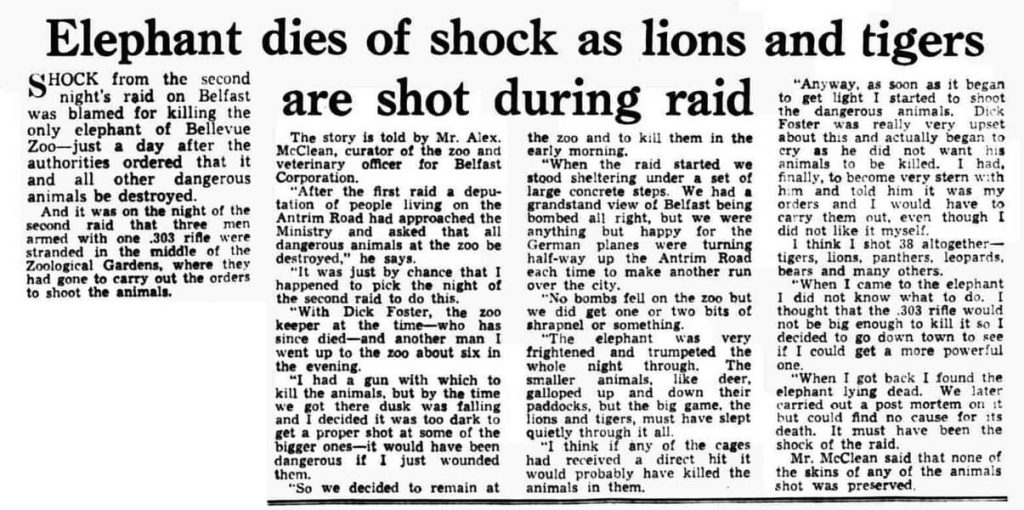
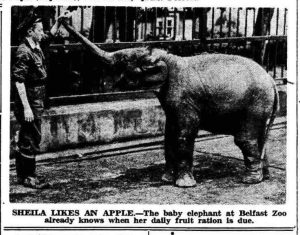
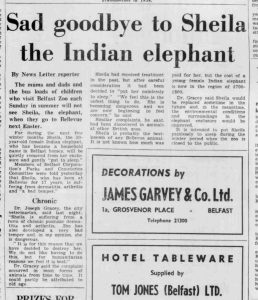 In essence, when articles were compiled this century, the researchers knew there was an elephant called Sheila at the zoo in 1938 and that an elephant called Sheila died at the zoo in 1965. Unfortunately, they made the assumption that the elephant that died in 1965 was the elephant who had arrived in 1938.
In essence, when articles were compiled this century, the researchers knew there was an elephant called Sheila at the zoo in 1938 and that an elephant called Sheila died at the zoo in 1965. Unfortunately, they made the assumption that the elephant that died in 1965 was the elephant who had arrived in 1938.

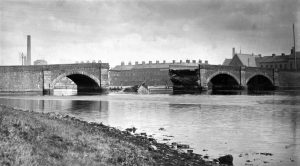
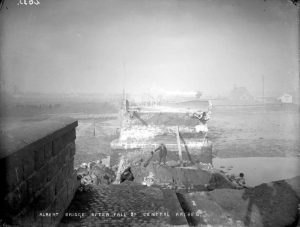
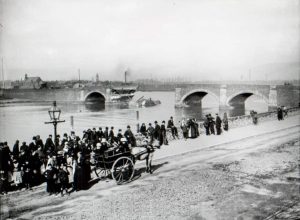 The
The 

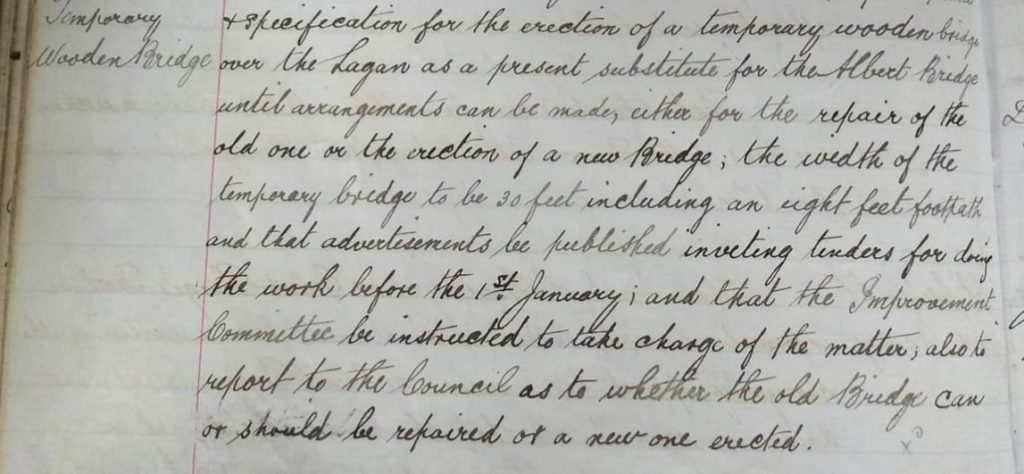 The
The 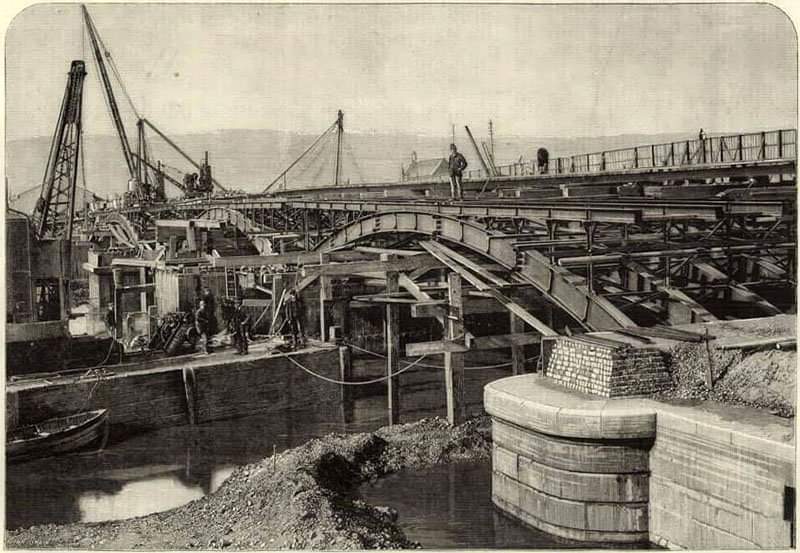
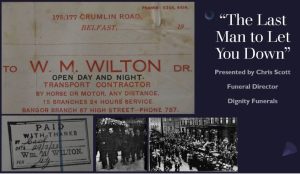
 Find out about the court case, in 1931, focusing around falsifying the age of a person during the death registration process. Hear all about the invention of a foghorn for a vault in 1932, specifically designed for those who feared premature burial! Chris will also talk about some of the funeral customs and superstitions from that era. “Never count the cars or people at a funeral” – Apparently it would bring you bad luck! The original Wilton Day books and other funeral related material will be available for inspection. Who knows – you might discover something to supplement your own family history research!
Find out about the court case, in 1931, focusing around falsifying the age of a person during the death registration process. Hear all about the invention of a foghorn for a vault in 1932, specifically designed for those who feared premature burial! Chris will also talk about some of the funeral customs and superstitions from that era. “Never count the cars or people at a funeral” – Apparently it would bring you bad luck! The original Wilton Day books and other funeral related material will be available for inspection. Who knows – you might discover something to supplement your own family history research! A colony of forty cottages, known collectively as St Quentin Park after the 1918 battle, was built in two phases in 1922 and 1923 on 10.5 acres of land purchased from Thomas Alexander Archbold of Hillview and Captain Robert Humphrey Bland of Tobarcooran for £1503-6-6, which equates to approximately 68,380 in current terms. Mr Archbold’s daughter, Jane Russell Archbold, had served with the Voluntary Aid Detachment as a Staff Nurse at the UVF Hospital in Belfast from January 1916 to February 1919. Captain Bland had served with the Royal Irish Rifles and the Labour Corps in the Great War. There were three cottage types in the colony with 38 semi-detached cottages and two detached cottages.
A colony of forty cottages, known collectively as St Quentin Park after the 1918 battle, was built in two phases in 1922 and 1923 on 10.5 acres of land purchased from Thomas Alexander Archbold of Hillview and Captain Robert Humphrey Bland of Tobarcooran for £1503-6-6, which equates to approximately 68,380 in current terms. Mr Archbold’s daughter, Jane Russell Archbold, had served with the Voluntary Aid Detachment as a Staff Nurse at the UVF Hospital in Belfast from January 1916 to February 1919. Captain Bland had served with the Royal Irish Rifles and the Labour Corps in the Great War. There were three cottage types in the colony with 38 semi-detached cottages and two detached cottages. 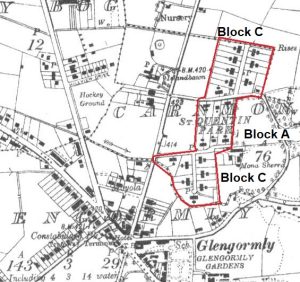 Work commenced in August 1921 and the ten cottages at Block A were completed in September 1922. The fourteen cottages at Block C were completed in January 1923 and the sixteen cottages at Block B were completed on 11th May 1923. The average size of each plot was 0.26 acres which provided a sizeable area in which the veterans could grow fruit and vegetable and the initial rent was five shillings per week (approximately £11pw in current terms). The cottages did not have a water supply and four pumps supplied water to forty households. The first record of occupants of the cottages appears in the 1924.
Work commenced in August 1921 and the ten cottages at Block A were completed in September 1922. The fourteen cottages at Block C were completed in January 1923 and the sixteen cottages at Block B were completed on 11th May 1923. The average size of each plot was 0.26 acres which provided a sizeable area in which the veterans could grow fruit and vegetable and the initial rent was five shillings per week (approximately £11pw in current terms). The cottages did not have a water supply and four pumps supplied water to forty households. The first record of occupants of the cottages appears in the 1924. 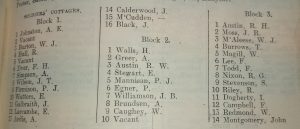 Isaac Doherty was born on 5th July 1877 at Ballyfinaghy to Robert Doherty and Anne Doherty (nee McGowan) and he married Mary Graham of Drew Street on 5th September 1912 at St Anne’s Parish Church. Isaac enlisted with the Royal Inniskilling Fusiliers and was posted to France with the Ulster Division in October 1915. He was serving with the Royal Engineers when he was transferred to the Class Z Army Reserve on 8th May 1919. In 1928, Mary’s daughter from her first marriage, Lily Graham, died at the Royal Victoria Hospital at the age of 21. Isaac Doherty was living at 909 Crumlin Road when he died on 24th February 1940, aged 63, and Mary Doherty died on 7th May 1957, aged 80. Isaac and Mary Doherty and Lily Graham are buried in Dundonald Cemetery.
Isaac Doherty was born on 5th July 1877 at Ballyfinaghy to Robert Doherty and Anne Doherty (nee McGowan) and he married Mary Graham of Drew Street on 5th September 1912 at St Anne’s Parish Church. Isaac enlisted with the Royal Inniskilling Fusiliers and was posted to France with the Ulster Division in October 1915. He was serving with the Royal Engineers when he was transferred to the Class Z Army Reserve on 8th May 1919. In 1928, Mary’s daughter from her first marriage, Lily Graham, died at the Royal Victoria Hospital at the age of 21. Isaac Doherty was living at 909 Crumlin Road when he died on 24th February 1940, aged 63, and Mary Doherty died on 7th May 1957, aged 80. Isaac and Mary Doherty and Lily Graham are buried in Dundonald Cemetery.  The Commonwealth War Graves Commission (CWGC) website includes a Civilian War Dead section which lists the place of death and the place of residence for fatalities, the information having been collated from the Civil Defence Authority fatality lists and other sources. The anomalies between the figures specified on the Belfast City Council plaques and the CWGC Civilian War Dead List (henceforth CWGC List) will be examined in this article.
The Commonwealth War Graves Commission (CWGC) website includes a Civilian War Dead section which lists the place of death and the place of residence for fatalities, the information having been collated from the Civil Defence Authority fatality lists and other sources. The anomalies between the figures specified on the Belfast City Council plaques and the CWGC Civilian War Dead List (henceforth CWGC List) will be examined in this article.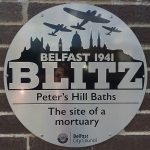 1 Temporary Mortuaries
1 Temporary Mortuaries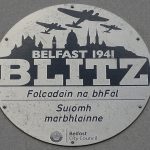
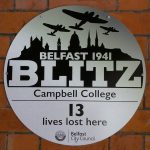 Campbell College was taken over by the military authorities as the 24th (London) General Hospital shortly after the start of the Second World War and was hit on the night of 4th/5th May 1941. The Blitz Victims List compiled by the Northern Ireland War Memorial records that 24 people died at the hospital, including one civilian fatality. Of the 23 army personnel killed, nine are buried in Northern Ireland and the remainder were repatriated to Great Britain for interment. The civilian was Mary Jane Close (58) who was injured at her home in Westbourne Street and died at the hospital and is buried in Dundonald Cemetery.
Campbell College was taken over by the military authorities as the 24th (London) General Hospital shortly after the start of the Second World War and was hit on the night of 4th/5th May 1941. The Blitz Victims List compiled by the Northern Ireland War Memorial records that 24 people died at the hospital, including one civilian fatality. Of the 23 army personnel killed, nine are buried in Northern Ireland and the remainder were repatriated to Great Britain for interment. The civilian was Mary Jane Close (58) who was injured at her home in Westbourne Street and died at the hospital and is buried in Dundonald Cemetery.
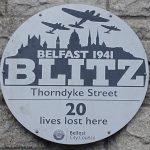 4 Mountpottinger – Thorndyke Street
4 Mountpottinger – Thorndyke Street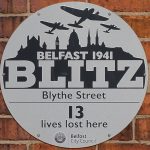 5 Sandy Row – Blythe Street
5 Sandy Row – Blythe Street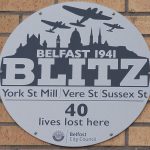
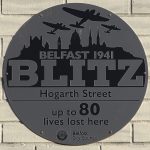 7 Tiger’s Bay – Hogarth Street
7 Tiger’s Bay – Hogarth Street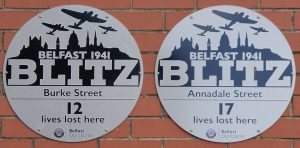
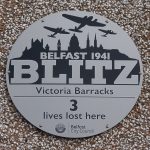
 10 Donegall Street – St Patrick’s Church
10 Donegall Street – St Patrick’s Church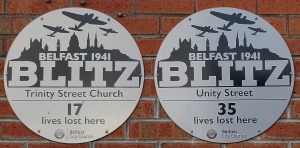 11 Carrick Hill – Unity Street and Trinity Street
11 Carrick Hill – Unity Street and Trinity Street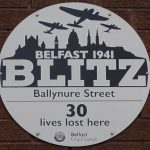
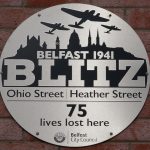
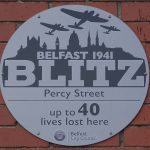
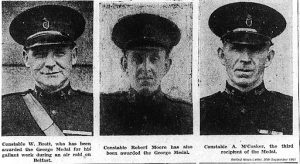
 During an air raid in May, Auxiliary Nurse Denise Forster (21) was on duty at the Ambulance Depot on the Holywood Road when it was demolished by a high explosive bomb.
During an air raid in May, Auxiliary Nurse Denise Forster (21) was on duty at the Ambulance Depot on the Holywood Road when it was demolished by a high explosive bomb. 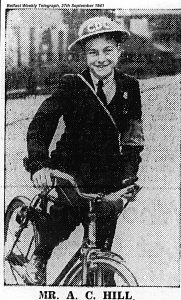 Messenger Alexander Cecil Hill (17), an office assistant from Convention Street, received the BEM. Although severely shaken by an explosion nearby, Alexander directed traffic at a main road whilst bombs were falling nearby. Later, whilst delivering an urgent message to the Report Centre, he was blown off his bicycle by explosions twice but each time he remounted and delivered the message.
Messenger Alexander Cecil Hill (17), an office assistant from Convention Street, received the BEM. Although severely shaken by an explosion nearby, Alexander directed traffic at a main road whilst bombs were falling nearby. Later, whilst delivering an urgent message to the Report Centre, he was blown off his bicycle by explosions twice but each time he remounted and delivered the message.  BEMs were awarded to Bomb Identification Officer William John Ford (51) and Messenger William Ernest Bennett (15) of Wandsworth Gardens for rescue work at Cliftonville Road where bombs had destroyed a number of houses and fractured a gas main. Ford and Bennett burrowed six yards through rubble to bring an elderly man to safety and then they rescued two stranded women from a house that was in danger of collapse. Bombs were falling as they worked and both suffered from the effects of inhaling coal gas. William Bennet later joined the National Fire Service.
BEMs were awarded to Bomb Identification Officer William John Ford (51) and Messenger William Ernest Bennett (15) of Wandsworth Gardens for rescue work at Cliftonville Road where bombs had destroyed a number of houses and fractured a gas main. Ford and Bennett burrowed six yards through rubble to bring an elderly man to safety and then they rescued two stranded women from a house that was in danger of collapse. Bombs were falling as they worked and both suffered from the effects of inhaling coal gas. William Bennet later joined the National Fire Service.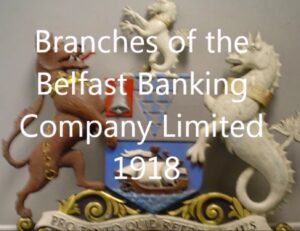 My interest in old bank buildings is primarily about the former Belfast Banking Company Limited (BBCo) branches in Ireland and the area later known as Northern Ireland. The BBCo was formed in 1827 and was merged in 1970 with Northern Bank. Its southern branches were sold to the Royal Bank of Ireland in 1923.
My interest in old bank buildings is primarily about the former Belfast Banking Company Limited (BBCo) branches in Ireland and the area later known as Northern Ireland. The BBCo was formed in 1827 and was merged in 1970 with Northern Bank. Its southern branches were sold to the Royal Bank of Ireland in 1923.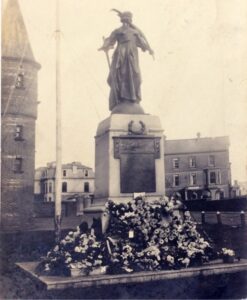 The nine feet nine inch tall pedestal of Irish limestone is surmounted by a seven feet and six inches bronze figure of Victory, with inverted sword in her right hand and a palm branch in her left hand. The monument was designed by Sir George James Frampton and the bronze figure was sculpted by Frank Ransom, both of whom were from London. The monument was constructed by William Kirkpatrick Limited and unveiled by Lady Macnaghten who had lost two sons within three months during the war.
The nine feet nine inch tall pedestal of Irish limestone is surmounted by a seven feet and six inches bronze figure of Victory, with inverted sword in her right hand and a palm branch in her left hand. The monument was designed by Sir George James Frampton and the bronze figure was sculpted by Frank Ransom, both of whom were from London. The monument was constructed by William Kirkpatrick Limited and unveiled by Lady Macnaghten who had lost two sons within three months during the war. Sir James Craig presided over the ceremony and in his speech, he stated that 300 men from Portrush’s population of 3,000 had enlisted with the Ulster Division and that the Spirit of Ulster had carried those men through the most appalling time. There was no reference to the men who served and died with other units of the British, Dominion, and Empire forces. The names of the fallen were read by Captain Sydney James Lyle who had served with the 12th Battalion Royal Irish Rifles and 6th Divisional Train of the Royal Army Service Corps, being awarded the Military Cross. The memorial was dedicated by the Reverend James Gilbert Paton of Malone Presbyterian Church and formerly of Terrace Row Presbyterian Church in Coleraine. He had served as a Chaplain in the Ulster Division, being attached to the 10th Battalion Royal Inniskilling Fusiliers, and was awarded the Military Cross with two Bars.
Sir James Craig presided over the ceremony and in his speech, he stated that 300 men from Portrush’s population of 3,000 had enlisted with the Ulster Division and that the Spirit of Ulster had carried those men through the most appalling time. There was no reference to the men who served and died with other units of the British, Dominion, and Empire forces. The names of the fallen were read by Captain Sydney James Lyle who had served with the 12th Battalion Royal Irish Rifles and 6th Divisional Train of the Royal Army Service Corps, being awarded the Military Cross. The memorial was dedicated by the Reverend James Gilbert Paton of Malone Presbyterian Church and formerly of Terrace Row Presbyterian Church in Coleraine. He had served as a Chaplain in the Ulster Division, being attached to the 10th Battalion Royal Inniskilling Fusiliers, and was awarded the Military Cross with two Bars.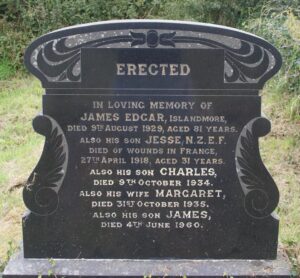

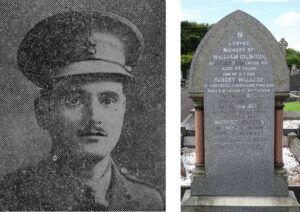 Robert Wallace Gilmour was born on 1st July 1885 at The Diamond in Coleraine where William Gilmour and Margaret Johnston Gilmour (nee Wallace) had a jewellery and watch-making business. Before the war, Robert Gilmour was employed as a Cashier in the Ulster Bank’s Pembroke branch in Dublin. He enlisted with the Connaught Rangers but was transferred to the Inns of Court Officers Training Corps and was commissioned into the Royal Inniskilling Fusiliers in December 1916. He was posted to 9th Battalion in France on 21st February 1917 and sustained gunshot wounds to the leg during the Battle of Messines. After a period of recuperation at home, Second Lieutenant Robert Wallace Gilmour returned to the Western Front and was Killed in Action during the German Spring Offensive in March 1918. He was 32 years of age and has no known grave, being commemorated on the Pozieres Memorial in France. Locally, he is commemorated on a family memorial in Coleraine Cemetery and on the memorial tablets for New Row Presbyterian Church in Coleraine and the Ulster Bank in Belfast.
Robert Wallace Gilmour was born on 1st July 1885 at The Diamond in Coleraine where William Gilmour and Margaret Johnston Gilmour (nee Wallace) had a jewellery and watch-making business. Before the war, Robert Gilmour was employed as a Cashier in the Ulster Bank’s Pembroke branch in Dublin. He enlisted with the Connaught Rangers but was transferred to the Inns of Court Officers Training Corps and was commissioned into the Royal Inniskilling Fusiliers in December 1916. He was posted to 9th Battalion in France on 21st February 1917 and sustained gunshot wounds to the leg during the Battle of Messines. After a period of recuperation at home, Second Lieutenant Robert Wallace Gilmour returned to the Western Front and was Killed in Action during the German Spring Offensive in March 1918. He was 32 years of age and has no known grave, being commemorated on the Pozieres Memorial in France. Locally, he is commemorated on a family memorial in Coleraine Cemetery and on the memorial tablets for New Row Presbyterian Church in Coleraine and the Ulster Bank in Belfast.
 Three females are commemorated on the memorial – Staff Nurse Emily Gray of the Queen Alexandra’s Imperial Military Nursing Service, Alicia Watt of the Queen Mary’s Army Auxiliary Corps, and Nurse Frances Emma Shortt of the Voluntary Aid Detachment. Frances Shortt was only added to the Commonwealth War Graves Commission database in recent years and a CWGC headstone was installed in the graveyard at Tullanisken Parish Church in Newmills in October 2022. The recognition of Nurse Shortt as an official war fatality was largely due the efforts of Kenneth Farquhar of Dungannon.
Three females are commemorated on the memorial – Staff Nurse Emily Gray of the Queen Alexandra’s Imperial Military Nursing Service, Alicia Watt of the Queen Mary’s Army Auxiliary Corps, and Nurse Frances Emma Shortt of the Voluntary Aid Detachment. Frances Shortt was only added to the Commonwealth War Graves Commission database in recent years and a CWGC headstone was installed in the graveyard at Tullanisken Parish Church in Newmills in October 2022. The recognition of Nurse Shortt as an official war fatality was largely due the efforts of Kenneth Farquhar of Dungannon.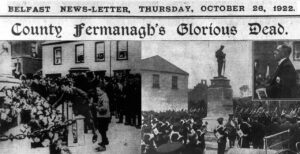
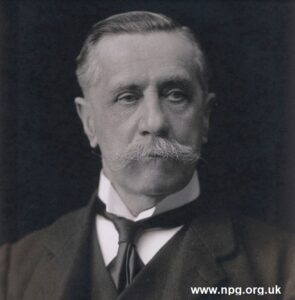 On that date, Edmund Bernard FitzAlan-Howard, 1st Viscount FitzAlan of Derwent, travelled from Belfast to Enniskillen, accompanied by Sir James Craig, Prime Minister of Northern Ireland. Mr A W G Ritchie, Town Clerk, read the council’s address to the Lord Lieutenant, which included these words, “
On that date, Edmund Bernard FitzAlan-Howard, 1st Viscount FitzAlan of Derwent, travelled from Belfast to Enniskillen, accompanied by Sir James Craig, Prime Minister of Northern Ireland. Mr A W G Ritchie, Town Clerk, read the council’s address to the Lord Lieutenant, which included these words, “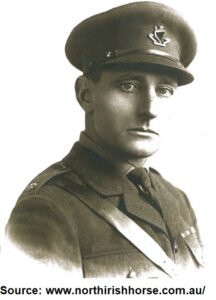 Richard Annesley West was born on 26th September 1878 at Oxford Street in Cheltenham to Augustus George West and Sara West nee Eyre and the family was living at Tullynagowan near Brookborough by 1901. On 8th January 1900, Richard West enlisted at Newbridge with the 45th Company, Imperial Yeomanry (also known as the Irish Hunt Squadron) and served in the Boer War from 13th March 1900 to 4th March 1901, seeing action at Lindley, Dewetsdorp and Riddesberg. After being discharged, he returned to South Africa where he married Maud Ethel Cushing on 16th July 1909. On the outbreak of war, Richard West sought a commission in the North Irish Horse but, as the War Office had not approved his commission, he enlisted as a Trooper and sailed for France with C Squadron on 20th August 1914. His commission, backdated to 11th August, was confirmed in September 1914 and he was later attached to the North Somerset Yeomanry and Tank Corps. Richard West commanded B Squadron of the North Somerset Yeomanry during the Battle of Arras and was awarded the Distinguished Service Order for his actions on 11th April 1917: “
Richard Annesley West was born on 26th September 1878 at Oxford Street in Cheltenham to Augustus George West and Sara West nee Eyre and the family was living at Tullynagowan near Brookborough by 1901. On 8th January 1900, Richard West enlisted at Newbridge with the 45th Company, Imperial Yeomanry (also known as the Irish Hunt Squadron) and served in the Boer War from 13th March 1900 to 4th March 1901, seeing action at Lindley, Dewetsdorp and Riddesberg. After being discharged, he returned to South Africa where he married Maud Ethel Cushing on 16th July 1909. On the outbreak of war, Richard West sought a commission in the North Irish Horse but, as the War Office had not approved his commission, he enlisted as a Trooper and sailed for France with C Squadron on 20th August 1914. His commission, backdated to 11th August, was confirmed in September 1914 and he was later attached to the North Somerset Yeomanry and Tank Corps. Richard West commanded B Squadron of the North Somerset Yeomanry during the Battle of Arras and was awarded the Distinguished Service Order for his actions on 11th April 1917: “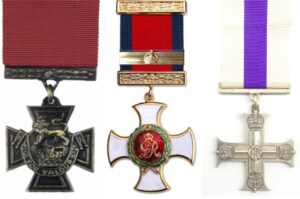 Richard West was awarded the Bar to his DSO for his actions on 21st August 1918 at Courcelles: “
Richard West was awarded the Bar to his DSO for his actions on 21st August 1918 at Courcelles: “ There was one woman recorded on the war memorial when it was unveiled – Marion Georgina Graham from Lisnaskea. She was born on 9th February 1880 at Casson in the Lisbellaw sub-district to Noble Graham and Dinah Noble (nee Carter) who farmed 53 acres of land at Drummack near Lisnaskea. Marion went into nursing and worked at the Meath Hospital in Dublin before joining the Colonial Nursing Service. She was posted to Nigeria on 27th August 1914 and had a period of home leave between October 1915 and February 1916. Marion was allowed a further period of home leave in 1917 and set sail from Lagos onboard SS Abosso, which was carrying passengers, mail and 3,500 tons of West African produce to Liverpool. SS Abosso, which had been constructed at Harland and Wolff in 1912, was torpedoed and sunk 180 miles from Fastnet by German submarine U-43 on the 24th April 1917. The Commonwealth War Graves Commission commemorates 25 crewmen and a Royal Navy seaman but does not commemorate the civilian passengers who died, including Marion Graham.
There was one woman recorded on the war memorial when it was unveiled – Marion Georgina Graham from Lisnaskea. She was born on 9th February 1880 at Casson in the Lisbellaw sub-district to Noble Graham and Dinah Noble (nee Carter) who farmed 53 acres of land at Drummack near Lisnaskea. Marion went into nursing and worked at the Meath Hospital in Dublin before joining the Colonial Nursing Service. She was posted to Nigeria on 27th August 1914 and had a period of home leave between October 1915 and February 1916. Marion was allowed a further period of home leave in 1917 and set sail from Lagos onboard SS Abosso, which was carrying passengers, mail and 3,500 tons of West African produce to Liverpool. SS Abosso, which had been constructed at Harland and Wolff in 1912, was torpedoed and sunk 180 miles from Fastnet by German submarine U-43 on the 24th April 1917. The Commonwealth War Graves Commission commemorates 25 crewmen and a Royal Navy seaman but does not commemorate the civilian passengers who died, including Marion Graham.